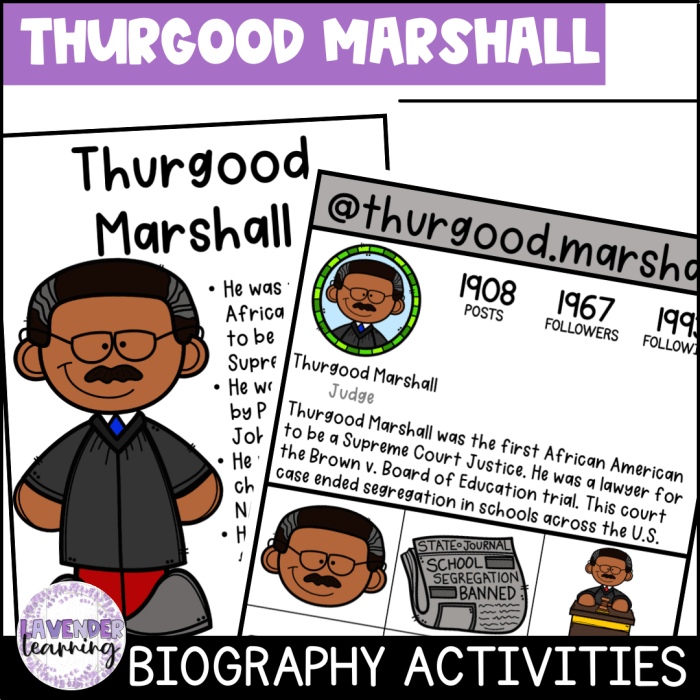Informational reading comprehension biography of Thurgood Marshall unveils the remarkable life and achievements of a civil rights icon. As a trailblazing lawyer and Supreme Court Justice, Marshall’s unwavering dedication to justice and equality left an indelible mark on American history.
From his early legal career to his pivotal role in the landmark Brown v. Board of Education case, Marshall’s unwavering determination challenged the foundations of segregation and discrimination, paving the way for a more just and equitable society.
Introduction: Informational Reading Comprehension Biography Of Thurgood Marshall

Thurgood Marshall, an eminent American lawyer and civil rights icon, dedicated his life to fighting for racial equality and justice. As the first African American Supreme Court Justice, he left an indelible mark on American jurisprudence and the nation’s civil rights movement.
Marshall’s tireless advocacy for equal rights and his groundbreaking legal victories played a pivotal role in dismantling the Jim Crow system of segregation and discrimination.
Education and Early Career
Thurgood Marshall was born in Baltimore, Maryland, in 1908. He graduated from Howard University School of Law in 1933 and began his legal career in Baltimore. As an African American lawyer in the early 20th century, he faced significant challenges and discrimination.
Undeterred, Marshall established a successful law practice and gained recognition for his legal acumen and unwavering commitment to civil rights.
The NAACP and Brown v. Board of Education
In 1940, Marshall joined the National Association for the Advancement of Colored People (NAACP) Legal Defense and Educational Fund. He became the organization’s chief counsel and led the legal strategy to challenge racial segregation in public schools.
The landmark case, Brown v. Board of Education, argued by Marshall before the Supreme Court in 1954, resulted in the unanimous decision to declare racial segregation in public schools unconstitutional. This victory marked a watershed moment in the civil rights movement.
Supreme Court Justice, Informational reading comprehension biography of thurgood marshall
In 1967, President Lyndon B. Johnson appointed Thurgood Marshall to the Supreme Court, making him the first African American to serve on the nation’s highest court.
As a Supreme Court Justice, Marshall consistently advocated for the rights of minorities, the poor, and the disenfranchised. His opinions and dissents played a significant role in shaping the Court’s jurisprudence and advancing civil rights.
Personal Life and Legacy
Thurgood Marshall was married to Cecilia Suyat Marshall, and they had two children. He was known for his strong work ethic, sharp wit, and unwavering determination.
Marshall’s legacy as a civil rights icon continues to inspire generations. His tireless advocacy for equality and his groundbreaking legal victories have left an enduring impact on American society.
FAQ Explained
What was Thurgood Marshall’s most significant contribution to the civil rights movement?
Thurgood Marshall’s most significant contribution was his role as lead counsel in Brown v. Board of Education, which successfully challenged the constitutionality of racial segregation in public schools.
How did Marshall’s early experiences shape his legal career?
Marshall’s experiences as an African American lawyer in the early 20th century exposed him to the pervasive racism and discrimination that fueled his passion for fighting for justice and equality.
What was Marshall’s impact on the Supreme Court?
Marshall’s appointment to the Supreme Court marked a significant milestone in the fight for civil rights. As a Justice, he consistently advocated for the rights of minorities and the underprivileged, leaving a lasting legacy on the Court’s jurisprudence.